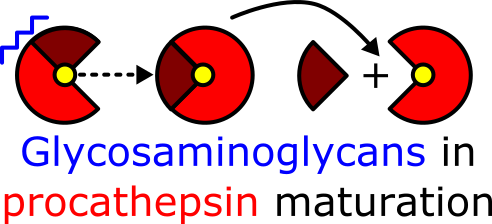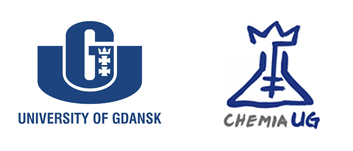PRELUDIUM

Computational insights into procathepsin maturation mediated by glycosaminoglycans
- PRELUDIUM from National Science Centre (Poland)
- 07.09.2019-06.10.2021
- 102 600 PLN (22 500 EUR)
- Project Leader: Kszysztof Bojarski
- Link to project description on NCN (Narodowe Centrum Nauki)

The goal of the proposed project is to study glycosaminoglycan-mediated maturation process of procathepsins by computational approaches. Cathepsins, lysosomal proteases, which are the active mature form of procathepsins, play a crucial role in the extracellular matrix in various processes such as bone resorption, intracellular proteolysis and regulation of programmed cell death. Their activity can be mediated by glycosaminoglycans, long unbranched periodic and negatively charged polysaccharides, by forming complexes with those proteases. The results of this research will bring novel atomistic insights into this group of complexes.
Cathepsins are protein-degrading enzymes that can be found in many living organisms. Most of them are cysteine proteases (Enzyme Commision number - EC 3.4.22) but are also cathepsins A and G which are serine proteases (EC 3.4.21) or cathepsins D and E which are aspartyl proteases (EC 3.4.23). To date we know that there are 15 members of this family with most of their structures experimentally available. Regardless differences in their amino acid sequences cathepsins share the same secondary structure pattern which is reflected in the same fold. Cathepsins play a vital role in diverse of biological processes such as bone resorption, intracellular proteolysis and regulation of programmed cell death. Changes in their activity in organism may lead to many serious diseases, either to pycnodysostosis in case of deficiency or to osteoporosis in case of excessive activity. However, enzymatic activity of the cathepsins can be moderated by glycosaminoglycans – a group of linear, periodic, negatively charged carbohydrates. This can occur through various inhibition pathways: i) glycosaminoglycan can bind into active site which makes it inaccessible for substrate; ii) glycosaminoglycan can bind on already formed complex between protein and substrate, on a ligand surface, which makes dissociation of substrate unable to occur; iii) glycosaminoglycan can bind to cathepsin in a way that causes allosteric change in active site which alters its accessiblility for a substrate.
In order to make cathepsin active, a propeptide has to be cut from procathepsin, the immature form of the protease. The process of procathepsin maturation can be promoted by the same procathepsin or by other procathepsin. Moreover, this process can be mediated by glycosaminoglycans. However, the exact molecular mechanism of procathepsin maturation is still unknown. The main goal of this project is to characterize the impact of glycosaminoglycans on the activity and maturation process of procathepsins in terms of the conformational changes in the protein induced by the interactions with glycosaminoglycans.
In order to computationally characterize the (pro)cathepsin/glycosaminoglycan complexes, one has to i) retrieve structures of ligand and receptor; ii) predict the structures of a complexes; iii) examine how the complexes behave in time; iv) estimate the complexes stabilities. Computational analysis of procathepsin complexes with glycosaminoglycans requires application of several approaches. First, procathepsin structures which are accessible from Protein Data Bank will be subjected to molecular dynamics simulations with the coarse-grained UNRES force field in order to get a deeper view on conformational ensemble of those proteases. Glycosaminoglycan structures, on the other hand, can be modeled. Using those models, complex structures can be calculated with use of the molecular docking method. Performing cluster analysis and picking most representative structures from each of the clusters, the calculated complex structures can be simulated by the molecular dynamics approach in order to study evolution of a system over time. Post-processing free energy analysis of the produced molecular dynamics trajectories by various approaches such as Molecular Mechanics-Poisson Boltzmann with the entropy calculations by normal mode, quasi harmonic analysis or potential of mean force approach can provide us valuable data on the stability of the complex. Moreover, additional per-residue analysis of free energy can identify aminoacid residues that contribute mostly to the interactions between receptor and ligand and in turn – to overall stability of a complex.
The expected results will contribute to the knowledge on procathepsins as well as on the molecular interactions of those proteins with GAGs and the effects of GAGs on the conformational aspects in the process of procathepsins maturation. Therefore, the data planned to be obtained might explain and support experimental literature data as well as serve as rational basis for guiding further experimental work. The results expected in this project might add to theoretical basis which can be used in regenerative medicine and therapies for numerous diseases involving glycosaminoglycan mediated processes.
